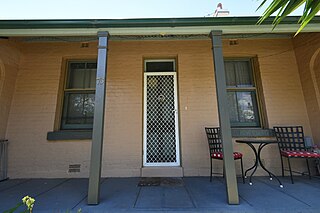Related Research Articles
Abortion is the termination of a pregnancy by removal or expulsion of an embryo or fetus. An abortion that occurs without intervention is known as a miscarriage or "spontaneous abortion"; these occur in approximately 30% to 40% of all pregnancies. When deliberate steps are taken to end a pregnancy, it is called an induced abortion, or less frequently "induced miscarriage". The unmodified word abortion generally refers to an induced abortion. The most common reason women give for having an abortion is for birth-timing and limiting family size. Other reasons reported include maternal health, an inability to afford a child, domestic violence, lack of support, feeling they are too young, wishing to complete education or advance a career, and not being able or willing to raise a child conceived as a result of rape or incest.
Abortion in Australia is legal at all stages of pregnancy. There are no federal abortion laws, and full decriminalisation of the procedure has been enacted in all jurisdictions. Access to abortion varies between the states and territories: surgical abortions are readily available on request within the first 22 to 24 weeks of pregnancy in most jurisdictions, and up to 16 weeks in Tasmania. Later term abortions can be obtained with the approval of two doctors, although the Australian Capital Territory only requires a single physician's approval.
Dilation and evacuation (D&E) is the dilation of the cervix and surgical evacuation of the uterus after the first trimester of pregnancy. It is a method of abortion as well as a common procedure used after miscarriage to remove all pregnancy tissue.

A self-induced abortion is an abortion performed by the pregnant woman herself, or with the help of other, non-medical assistance. Although the term includes abortions induced outside of a clinical setting with legal, sometimes over-the-counter medication, it also refers to efforts to terminate a pregnancy through alternative, potentially more dangerous methods. Such practices may present a threat to the health of women.

Population Services International (PSI) is a 501(c)(3) registered nonprofit global health organization that began as an international not-for-profit provider of contraception and safe abortion services, and has evolved into developing and deploying programs today that target malaria, child survival, HIV, and reproductive health. PSI provides products, clinical services and behavior change communications for the health of people in high-need populations.
Governments sometimes take measures designed to afford legal protection of access to abortion. Such legislation often seeks to guard facilities which provide induced abortion against obstruction, vandalism, picketing, and other actions, or to protect patients and employees of such facilities from threats and harassment.

Abortion in South Africa is legal by request when the pregnancy is under 13 weeks. It is also legal to terminate a pregnancy between week 13 and week 20 under the following conditions: the continued pregnancy would significantly affect the pregnant person's social or economic circumstances, the continued pregnancy poses a risk of injury to the pregnant person's physical or mental health, there is a substantial risk that the foetus would suffer from a severe physical or mental abnormality, or the pregnancy resulted from rape or incest. If the pregnancy is more than 20 weeks, a termination is legal if the foetus' life is in danger, or there is a likelihood of serious birth defects.
The genetics and abortion issue is an extension of the abortion debate and the disability rights movement. Since the advent of forms of prenatal diagnosis, such as amniocentesis and ultrasound, it has become possible to detect the presence of congenital disorders in the fetus before birth. Specifically, disability-selective abortion is the abortion of fetuses that are found to have non-fatal mental or physical defects detected through prenatal testing. Many prenatal tests are now considered routine, such as testing for Down syndrome. Women who are discovered to be carrying fetuses with disabilities are often faced with the decision of whether to abort or to prepare to parent a child with disabilities.

The Elsie Refuge for women and children was a women's refuge set up in Glebe, Sydney in 1974. The project was the beginning of the NSW Women's Refuge Movement that responded to the needs of women and children escaping domestic violence by providing access to specialist accommodation and support services operating within a feminist framework.
Geoffrey Lancelot Rutter Davis (1933-2008) was an Australian medical doctor, who rose to prominence in Sydney in the 1970s as a leading provider of contraception and abortion services. He was also the owner for nearly 50 years of The Abbey, a 50-room mansion in the Sydney inner suburb of Annandale.
A medical abortion, also known as medication abortion, occurs when drugs (medication) are used to bring about an abortion. Medical abortions are an alternative to surgical abortions such as vacuum aspiration or dilation and curettage. Medical abortions are more common than surgical abortions in most places around the world.
Abortion in Thailand is legal and available on-request up to 20 weeks of pregnancy. Abortion has been legal up to at least 12 weeks of pregnancy since 7 February 2021. Following a 2020 ruling of the Constitutional Court which declared a portion of the abortion statutes unconstitutional, the Parliament removed first-term abortion from the criminal code. Once strict, over time laws have been relaxed to take into account high rates of teen pregnancy, women who lack the means or will to raise children, and the consequences of illegal abortion.
Abortion in Queensland, Australia, is available on request in the first 22 weeks of pregnancy, with the approval of two doctors usually required for later terminations of pregnancy. Queensland law prohibits protesters from coming within 150 metres of an abortion clinic and requires conscientiously objecting doctors to refer women seeking an abortion to a doctor who will provide one. The current legal framework was introduced by the Palaszczuk Labor Government with the passage of the Termination of Pregnancy Act by the Parliament of Queensland on 17 October 2018 in a conscience vote. Before the Termination of Pregnancy Act took effect on 3 December 2018, abortion was subject to the Criminal Code and the common law McGuire ruling, which made abortion unlawful unless the abortion provider had a reasonable belief that a woman's physical or mental health was at risk. Availability varies across the state, and is more limited in rural and remote areas outside South East Queensland. In the absence of standardised data collection, it is estimated that between 10,000 and 14,000 abortions occur every year in Queensland.
Abortion in the U.S. state of Virginia is legal up to the end of the second trimester of a pregnancy. Before the year 1900, abortion remained largely illegal in Virginia, reflecting a widespread trend in many U.S. states during the 19th and early 20th centuries. Abortion was viewed as a criminal act and subject to state laws that prohibited it. However, by 1950, Virginia introduced a legal therapeutic exception, allowing for abortion under specific circumstances, primarily when a woman's physical or mental health was at risk. Notably, the University of Virginia Hospital established a review board in 1950 responsible for evaluating and approving abortion requests, particularly those grounded in psychiatric reasons. This thorough approval process resulted in a significant decrease in the number of abortions performed at the hospital.
The NSW Women's Refuge Movement began in 1974 with the establishment of Elsie Refuge in Glebe, NSW. Other refuges were established throughout the 1970s, operating within a feminist framework and responding to the needs of women and children escaping domestic violence. At first, the refuges were developed through volunteer effort and without government funding. Gradually the government took over funding of the refuges, with the states funding the buildings and the federal government funding the running costs. The NSW Women's Refuge Movement continued to provide services to women with diverse needs and to raise awareness about domestic violence.
Population Services International (Australasia) was an Australian based subsidiary of Population Services International. PSI Australasia operated as a not-for-profit corporation, continuously registered in Australia from mid-1973 to 1992, with the mission of providing contraception and abortion services.
Australia's Royal Commission on Human Relationships was established in August 1974 by Prime Minister Gough Whitlam of the Australian Labor Party (ALP) after the failure in 1973 of the government to pass reforms to the country's abortion legislation.
Lynette "Lyn" Syme (1948-2019) was an Australian political and labor activist, feminist and aboriginal land-rights advocate, recognized in her later years as a Wiradjuri elder of the Dabee people in what is current-day New South Wales.
Control Abortion Referral Service was a feminist Australian organisation 1973 to late 1980s. It advised and supported women seeking abortion from New South Wales, other Australian states and from abroad, particularly from New Zealand. It also developed new women-run abortion services.
Women's Liberation House, also known simply as Women's House, was the headquarters for the Women's Liberation Movement and epicentre for organizing around issues impacting women in Sydney and across Australia from the late-1960s through the 1990s.
References
- 1 2 3 4 5 6 7 8 9 10 11 Alexander, Harriet (15 September 2019). "Fire, vandalism and spit: the forging of a safe abortion service". Sydney Morning Herald . Retrieved 29 November 2023.
- 1 2 3 4 5 6 McIlraith, Shaun (21 January 1975). "Preterm prevents agony of shopping around". The Sydney Morning Herald. p. 8. Retrieved 29 November 2023.
- ↑ "Instant abortion' clinic". The Canberra Times. 20 June 1974. p. 12.
- 1 2 "PRETERM FOUNDATION CLINIC OPERATIVE". Tribune (Sydney, NSW). 23 July 1974. p. 12. Retrieved 29 November 2023.
- ↑ McIlraith, Shaun (20 January 1975). "Abortions are legal – and widespread – in NSW". The Sydney Morning Herald. Retrieved 29 November 2023.
- 1 2 "FORUMS ON ABORTION IN WOMEN'S CAMPAIGN". Tribune (Sydney, NSW). 16 September 1975. p. 12. Retrieved 11 December 2023.
- 1 2 "Preterm". Tribune (Sydney, NSW). 8 April 1975. p. 3. Retrieved 29 November 2023.
- ↑ "$2m fire destroys clinic". The Age (Melbourne). 8 April 1975. p. 3.
- 1 2 3 4 5 6 al, Margaret Hooks, et (1977), English: ABORTION OUR BODIES THEIR POWER, pamphlet on abortion services and reproductive rights in Australia, 1977 (PDF), retrieved 2023-11-29
{{citation}}: CS1 maint: multiple names: authors list (link) - ↑ "SYDNEY: The premises of Preterm ..." Tribune (Sydney, NSW). 8 April 1975. p. 3. Retrieved 29 November 2023.
- ↑ "PRETERM". Tribune (Sydney, NSW). 16 April 1975. p. 9. Retrieved 29 November 2023.
- ↑ McIlraith, Shaun (3 February 1977). "Asessing the demand for abortion". The Sydney Morning Herald. p. 9.
- ↑ Cunningham, James (30 August 1975). "Birth control expert loos at the Cross". The Sydney Morning Herald. p. 2.
- ↑ "St. Ann's Hospital, Killara. Angela Bamforth and Megan Sharpe, two of the staff who counsel women seeking abortions at Sydney's Preterm clinic", Getty Images/Fairfax Media Archives, 16 October 1975. Consulted 11 December 2023. https://www.gettyimages.ae/detail/news-photo/st-anns-hospital-killara-angela-bamforth-and-megan-sharpe-news-photo/1079656812
- 1 2 3 "ABORTION CLINIC SACKS WORKERS". Tribune (Sydney, NSW). 28 September 1977. p. 11. Retrieved 18 December 2023.
- ↑ ""FORUM" ANTI-FEMINIST ATTACKS". Woroni (Canberra, ACT). 8 September 1980. p. 19. Retrieved 18 December 2023.
- 1 2 Alexander, Harriet (3 September 2015). "Oldest Sydney abortion clinic Preterm closes its doors". The Sydney Morning Herald. Retrieved 29 November 2023.